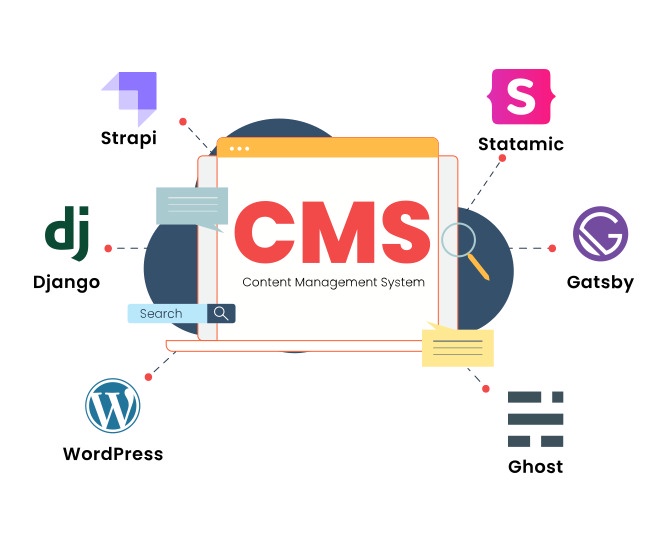Introduction
Are you struggling to convert website visitors into customers? Creating dynamic landing pages with a Content Management System (CMS) might just be the solution you need! A CMS is a powerful tool that allows you to manage and update your website's content easily. By partnering with a CMS development company and utilizing their CMS development services, you can design and tailor landing pages that dynamically respond to user interactions and preferences. In this blog, we'll explore how leveraging a CMS can significantly boost your conversions, turning more visitors into satisfied customers.
Understanding Dynamic Landing Pages
- Definition and characteristics:
- Dynamic landing pages are web pages that change their content based on user behavior or preferences.
- They offer personalized experiences, adapting to the visitor's interests and past interactions.
- Benefits of using dynamic landing pages:
- Higher conversion rates: Personalized content increases user engagement and conversions.
- Improved user experience: Tailored content provides relevant information, enhancing user satisfaction.
- A/B testing efficiency: Easy to test different variations for optimal performance.
- Enhanced targeting: Precise targeting of specific customer segments.
- Examples of successful dynamic landing pages:
- E-commerce sites showing personalized product recommendations.
- Subscription services offering location-based offers.
- Travel websites displaying dynamic deals based on user preferences.
Choosing the Right CMS for Dynamic Landing Pages
- Key features to look for in a CMS:
- Flexible content management: Allows easy creation and modification of landing pages.
- Personalization capabilities: Ability to customize content for different users.
- A/B testing support: Built-in tools for testing different page variations.
- Integration options: Seamless integration with other marketing tools.
- Popular CMS options for creating dynamic landing pages:
- WordPress with plugins like Elementor and Divi.
- Joomla with JoomShaper's Page Builder.
- HubSpot CMS with advanced personalization features.
- Factors to consider in the selection process:
- Budget and cost-effectiveness of the CMS development services.
- User-friendliness and ease of learning for your team.
- Scalability and ability to handle increasing traffic and content.
Crafting Compelling Landing Page Content
- Identifying the target audience:
- Research your audience's preferences, pain points, and interests.
- Tailor content to resonate with their specific needs.
- Writing persuasive headlines and subheadings:
- Create attention-grabbing headlines that convey value.
- Use subheadings to break content and make it scannable.
- Utilizing engaging visuals and multimedia:
- Include relevant images, videos, or infographics to enhance the page.
- Visuals should complement the written content and support the message.
- Incorporating clear call-to-action (CTA):
- Place a prominent and compelling CTA button on the page.
- Clearly state what action you want the visitor to take.
Personalization and A/B Testing
- Importance of Personalization: Personalization tailors the landing page content to match the interests and preferences of individual visitors. It enhances user experience and boosts conversions.
- A/B Testing: A/B testing compares different versions of a landing page to identify which one performs better with visitors.
- Dynamic Landing Pages: Creating personalized content blocks that change based on user data can improve engagement and conversion rates.
- Implementing A/B Testing: CMS development companies can integrate A/B testing tools to experiment and refine landing page elements.
- Analyzing Test Results: Analyze metrics like click-through rates and conversion rates to determine the most effective version.
Mobile Responsiveness and Page Speed
- Mobile-Friendly Landing Pages: With the increasing use of mobile devices, having mobile-responsive landing pages is crucial for reaching a wider audience and improving conversions.
- Page Loading Speed: Slow loading times can lead to higher bounce rates. Optimize images, use caching, and leverage a content delivery network (CDN) to improve page speed.
- Impact on Conversions: Mobile-responsive pages with fast loading times provide a better user experience, leading to higher conversion rates.
SEO Optimization for Landing Pages
- Keyword Research: Identify relevant keywords to target your ideal audience and attract organic traffic to your landing pages.
- On-Page SEO: Optimize landing page elements like title tags, meta descriptions, headings, and content with targeted keywords.
- Link Building: Create quality backlinks from reputable websites to improve search engine rankings and increase landing page visibility.
- CMS Development Company: Hiring a professional CMS development company can ensure your landing pages are optimized for SEO and perform better in search engine results.
Integrating Forms and Data Collection
Forms are essential for collecting valuable data from your website visitors. Here's what you need to know:
- Types of forms for lead generation
- Contact forms: Gather basic information from visitors.
- Signup forms: Capture users for newsletters or memberships.
- Feedback forms: Collect opinions to improve your services.
- Best practices for form design and placement
- Keep it simple: Use clear, concise fields to avoid confusion.
- Visible placement: Put forms where visitors can easily find them.
- Call-to-action (CTA): Engage users with compelling CTAs.
- Data privacy and security considerations
- Use SSL encryption: Ensure data is transmitted securely.
- Compliance: Follow data protection regulations (e.g., GDPR).
- Secure storage: Safeguard collected data from unauthorized access.
Leveraging Dynamic Content Blocks
Dynamic content enhances user experience. Here's how to make the most of it:
- Customizing content based on user behavior and preferences
- Personalization: Tailor content to individual interests.
- User history: Show relevant content based on past interactions.
- Geo-targeting: Display location-specific content.
- Using dynamic modules for easy updates
- Effortless changes: Update content without technical knowledge.
- Time-sensitive content: Set automatic content expiration.
- A/B testing: Compare different content variations for effectiveness.
- Cross-promotion and upselling with dynamic content
- Related products/services: Showcase items based on user preferences.
- Upselling opportunities: Suggest higher-tier options to increase sales.
- Limited-time offers: Create urgency to encourage conversions.
Analyzing Performance Metrics
When developing a food delivery app, it's essential to analyze its performance regularly. This helps identify areas for improvement and ensures the app's success. Here are some key points to understand performance metrics:
1. Tracking and Measuring Landing Page Performance:
- Landing pages are critical for app success; they are the first impression on users.
- Measure landing page performance using key metrics like page views, bounce rate, and conversion rate.
- Page views: Number of times the landing page is viewed.
- Bounce rate: Percentage of visitors who leave the page without taking any action.
- Conversion rate: Percentage of visitors who complete the desired action, like signing up or placing an order.
2. Key Metrics to Focus On:
- App Downloads: Track the number of app downloads to gauge its popularity.
- User Engagement: Measure user interactions, like session duration and screen views.
- Retention Rate: Monitor how many users continue using the app over time.
- Order Frequency: Analyze how often users place orders through the app.
- Customer Feedback: Collect feedback to identify areas for improvement.
3. Tools for Performance Analysis and Reporting:
- Google Analytics: Provides detailed insights into user behavior and app performance.
- Mixpanel: Helps track user actions and engagement.
- Firebase Analytics: Offers app usage and conversion tracking.
- App Store Console: Provides download and user behavior data for app owners.
Conclusion
In conclusion, incorporating dynamic landing pages through CMS development can be a game-changer for your online business. With the assistance of a skilled CMS development company, you can harness the full potential of CMS technology to create personalized, engaging, and conversion-focused landing pages. The flexibility and ease of use provided by CMS development services enable you to adapt your pages according to user behavior, preferences, and trends. By doing so, you'll significantly increase your chances of converting visitors into loyal customers, ultimately driving business growth and success. Embrace the power of CMS-driven landing pages and unlock new opportunities for your online endeavors.


No comments yet